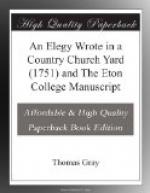One of the author’s prescriptions for publication concerned the verse form. He told Walpole that Dodsley must “print it without any Interval between the Stanza’s, because the Sense is in some Places continued beyond them.” In the Egerton MS Gray had written the poem with no breaks to set off quatrains, but in the earlier MS (Eton College), where the poem is entitled, “Stanza’s, wrote in a Country Church-Yard,” the quatrains are spaced in normal fashion. The injunction shows Gray’s sensitiveness as to metrical form. He had called the poem an Elegy only after urging by Mason, and he possibly doubted if his metre was “soft” enough for true elegy. The metre hitherto had not been common in elegies, though James Hammond’s “Love Elegies” (1743) had used it and won acclaim. But the heroic (hendecasyllabic) quatrain was regarded in general as too lofty, stately, cool, for elegy. For the universal aspect of Gray’s lament, however, it was highly apt as compared with the less majestic octosyllabic line, hitherto normal in this genre. For years after Gray’s great success, however, most elegies, if in quatrain form, followed Gray’s quatrain in manner, whether or not their subjects demanded the stately line.
The reasons why Gray is almost a poet of only one poem are not far to seek. He did not covet applause, and apart from melancholy his own emotions were too private to be published. In the “Elegy” he is true to himself and to the spirit of his age—perhaps of most ages. When he sought for material outside of his own experience, he went curiously to books, and was captivated by the “recherche.” He was also caught by the rising cult of sublimity in his two great pindaric odes, and by the cult of the picturesque in his flirtations with Scandinavian materials. In these later poems he broadened the field of poetic material notably; but in them he hardly deepened the imaginative or emotional tone: his manner, rather, became elaborate and theatrical. The “Elegy” is the language of the heart sincerely perfected.
The poem has pleased many and pleased long—throughout two centuries. In part it works through “pleasing melancholy”; in part it appeals to innumerable humble readers conscious of their own unheralded merit. Inevitably, since the industrial revolution, modernist critics have tended to stress its appeal to class consciousness. This appeal, real though it is, can be overemphasized. The rude forefathers are not primarily presented as underprivileged. Though poverty-stricken and ignorant, they are happy in family life and jocund in the field. “Nature is nature wherever placed,” as the intellectuals of Gray’s time loved to say, and the powers of the village fathers, potentially, equal the greatest; their virtue is contentment. They neither want nor need “storied urn or animated bust.” If they are unappreciated by Ambition, Grandeur, Pride, et al., the lack of appreciation is due to a corruption of values. The value commended in the




